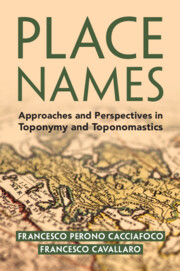Book contents
- Place Names
- Place Names
- Copyright page
- Contents
- Figures
- Tables
- Preface
- Acknowledgements
- 1 Introduction
- 2 Language Change
- 3 Historical Toponomastics
- 4 Toponymy and the Historical-Linguistic Reconstruction of Proto-Languages
- 5 Diachronic Toponymy
- 6 Landscape and Toponymy
- 7 Historical Toponomastics and Historical Geography
- 8 Synchronic Toponymy
- 9 Place Names and Society
- 10 Toponymy and Cartography
- Glossary
- References
- Index
4 - Toponymy and the Historical-Linguistic Reconstruction of Proto-Languages
Published online by Cambridge University Press: 02 March 2023
- Place Names
- Place Names
- Copyright page
- Contents
- Figures
- Tables
- Preface
- Acknowledgements
- 1 Introduction
- 2 Language Change
- 3 Historical Toponomastics
- 4 Toponymy and the Historical-Linguistic Reconstruction of Proto-Languages
- 5 Diachronic Toponymy
- 6 Landscape and Toponymy
- 7 Historical Toponomastics and Historical Geography
- 8 Synchronic Toponymy
- 9 Place Names and Society
- 10 Toponymy and Cartography
- Glossary
- References
- Index
Summary
The aim of a toponymist is to reconstruct and analyse the most original or ancient possible root of a toponym. This requires the linguist to go back to prehistoric times. Yet, at a certain point, scholars will run out of historical sources that can be analysed. They can then postulate the existence of pre-languages that predate proto-languages (since toponymic roots belong to proto-languages). Both types of prehistoric languages are unattested, but a proto-language can be reconstructed by using historical-linguistic methods, while a pre-language cannot. This chapter focusses on the most well-researched language family in the world, Indo-European, and surveys a number of theories on the origins of the speakers of Proto-Indo-European and their relations to Pre-Indo-European civilisations. Toponyms are often ‘linguistic relics’ and, at times, can provide useful insights into pre- and proto-languages spoken in prehistoric times and the dynamics between ancient groups of speakers. This is discussed through the analyses of two case studies, and shows that a root may be reused and refunctionalised in a new proto-language and acquire new meanings and uses.
Keywords
- Type
- Chapter
- Information
- Place NamesApproaches and Perspectives in Toponymy and Toponomastics, pp. 80 - 113Publisher: Cambridge University PressPrint publication year: 2023



